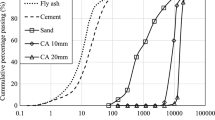Abstract
The water permeability of two series of concretes made with one type of fly ash and two types of Portland cement (OPC and SRPC) was tested by the method prescribed by DIN 1048. It is concluded that the cementing efficiency factor of the fly ash with respect to water permeability is approximately 0.3, independent of type of cement and curing time (28 days and 56 days). In practical terms this means that 1 kg of cement would have to be replaced by approximately 3 kg of fly ash in order to maintain the same watertightness of the hardened fly ash concretes. Thus, addition of fly ash is not likely to improve the watertightness of concrete.
Resume
On a essayé par la méthode DIN 1048 la perméabilité à l’eau de deux séries de bétons fabriqués avec un type de cendres volantes et deux types de ciment Portland (OPC et SRPC). On en a conclu que le coefficient d’activité des cendres volantes en rapport avec la perméabilité à l’eau est environ de 0,3, quels que soient le type de ciment et le temps de conservation (28 et 56 jours). Ceci signifie qu’il conviendrait de remplacer 1 kg de ciment par environ 3 kg de cendres volantes afin de maintenir une étanchéité constante des bétons aux cendres volantes durcis. L’addition de cendres volantes n’améliore donc pas sensiblement l’étanchéité à l’eau du béton.
Similar content being viewed by others
References
Helmuth, R., ‘Fly Ash in Cement and Concrete’ (Portland Cement Association, Research and Development Laboratories, Skokie, Illinois, 1987) pp. 76–79.
‘Wasserundurchlässigkeit von Festbeton’, DIN 1048, Blatt 1, Teil 4.7 (1972).
Walz, K., ‘Grundlagen und praktische Bedeutung der Undurchlässigkeit des Betons gegen Flüssigkeiten’,Bau u. Bauindustrie 3 (1968) 122–129.
Hedegaard, S. E. and Hansen, T. C., ‘Modified water/cement ratio law for compressive strength of fly ash concretes’,Mater. Struct. 25(149) (1992) 273–283.
Hansen, T. C. and Hedegaard, S. E., ‘Properties of fresh fly ash concretes’,ibid. 25(150) (1992) 347–354.
Møller, L. E., ‘Tæthed af Flyveaskebeton-Overfladeproblematik,’. Technical Report 157/85 (Building Materials Laboratory, Technical University of Denmark, Lyngby, 1985, in Danish).
Sall, J., ‘SAS Regression Application’, SAS Institute Technical Report A-102, Revised 7 August 1987 (SAS Institute, Cary, North Carolina).
Hedegaard, S. E., ‘Flyveaskebeton. Proportionering og tæthed over for indtrænging af klorider og vand’, Technical Report 221/90 (Building Materials Laboratory, Technical University of Denmark, Lyngby, 1990) (in Danish).
Author information
Authors and Affiliations
Rights and permissions
About this article
Cite this article
Hedegaard, S.E., Hansen, T.C. Water permeability of fly ash concretes. Materials and Structures 25, 381–387 (1992). https://doi.org/10.1007/BF02472253
Issue Date:
DOI: https://doi.org/10.1007/BF02472253




